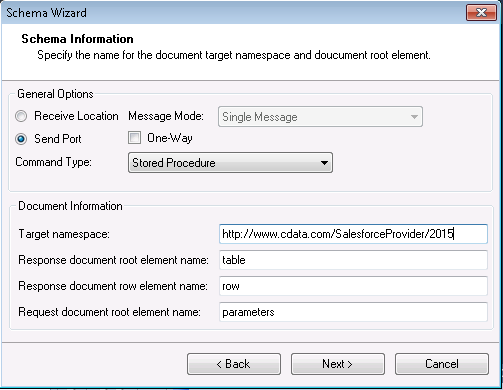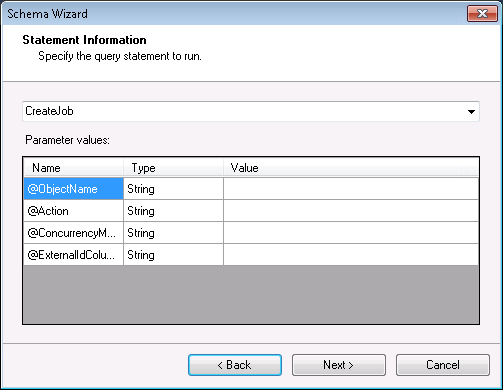Discover how a bimodal integration strategy can address the major data management challenges facing your organization today.
Get the Report →Execute Stored Procedures to SingleStore in BizTalk
You can use stored procedures provided by the CData BizTalk Adapter for SingleStore to automate working with SingleStore data in BizTalk. Stored procedures implement actions available in the underlying API.
Stored procedures implement SingleStore actions that cannot be represented as SELECT, INSERT, UPDATE, and DELETE statements. This article shows how to generate a schema for a stored procedure. You can use the schema to execute the stored procedure from a send port.
Add the Adapter to Your Project
Use the Add Adapter wizard to add the adapter to a BizTalk Server project in Visual Studio. The adapter will return metadata about the inputs of the stored procedure and its results. This metadata is needed to create the schema.
- Right-click on the project in the Solution Explorer and click Add -> Add Generated Items.
- Select Add Adapter Metadata in the resulting dialog box.
- In the resulting Add Adapter wizard, select the adapter from the list.
- In the Port menu, leave the selection blank. Or, select a receive location or send port that has been configured to use the SingleStore Adapter.
![CData Adapters in the Select Adapter wizard. (Salesforce is shown.)]()
On the Connection String page, enter authentication credentials and other connection properties if they were not already configured in the send port or the receive location.
Below is a typical connection string:
User=myUser;Password=myPassword;Database=NorthWind;Server=myServer;Port=3306;The following connection properties are required in order to connect to data.
- Server: The host name or IP of the server hosting the SingleStore database.
- Port: The port of the server hosting the SingleStore database.
- Database (Optional): The default database to connect to when connecting to the SingleStore Server. If this is not set, tables from all databases will be returned.
Connect Using Standard Authentication
To authenticate using standard authentication, set the following:
- User: The user which will be used to authenticate with the SingleStore server.
- Password: The password which will be used to authenticate with the SingleStore server.
Connect Using Integrated Security
As an alternative to providing the standard username and password, you can set IntegratedSecurity to True to authenticate trusted users to the server via Windows Authentication.
Connect Using SSL Authentication
You can leverage SSL authentication to connect to SingleStore data via a secure session. Configure the following connection properties to connect to data:
- SSLClientCert: Set this to the name of the certificate store for the client certificate. Used in the case of 2-way SSL, where truststore and keystore are kept on both the client and server machines.
- SSLClientCertPassword: If a client certificate store is password-protected, set this value to the store's password.
- SSLClientCertSubject: The subject of the TLS/SSL client certificate. Used to locate the certificate in the store.
- SSLClientCertType: The certificate type of the client store.
- SSLServerCert: The certificate to be accepted from the server.
Connect Using SSH Authentication
Using SSH, you can securely login to a remote machine. To access SingleStore data via SSH, configure the following connection properties:
- SSHClientCert: Set this to the name of the certificate store for the client certificate.
- SSHClientCertPassword: If a client certificate store is password-protected, set this value to the store's password.
- SSHClientCertSubject: The subject of the TLS/SSL client certificate. Used to locate the certificate in the store.
- SSHClientCertType: The certificate type of the client store.
- SSHPassword: The password that you use to authenticate with the SSH server.
- SSHPort: The port used for SSH operations.
- SSHServer: The SSH authentication server you are trying to authenticate against.
- SSHServerFingerPrint: The SSH Server fingerprint used for verification of the host you are connecting to.
- SSHUser: Set this to the username that you use to authenticate with the SSH server.
![The connection string properties used by the SingleStore Adapter. (Salesforce is shown.)]()
Generate the Schema
After you enter connection properties in the Add Adapter wizard, the Schema wizard is displayed.
- On the next page, Schema Information, select the Send Port that you have configured to use the SingleStore Adapter.
- If you have configured the CData SingleStore Adapter in a solicit-response send port, disable the One-Way option.
- In the Command Type menu, select Stored Procedure.
![Schema options for a stored procedure. (Salesforce is shown.)]()
- Select the stored procedure from the menu and enter the values for the input parameters.
![Input parameters and values. (Salesforce is shown.)]()
- Confirm the settings in the summary displayed by the wizard and click Finish to generate the schema.xsd file.
Processing Schemas
To use schemas in a simple BizTalk application, see the tutorial.










